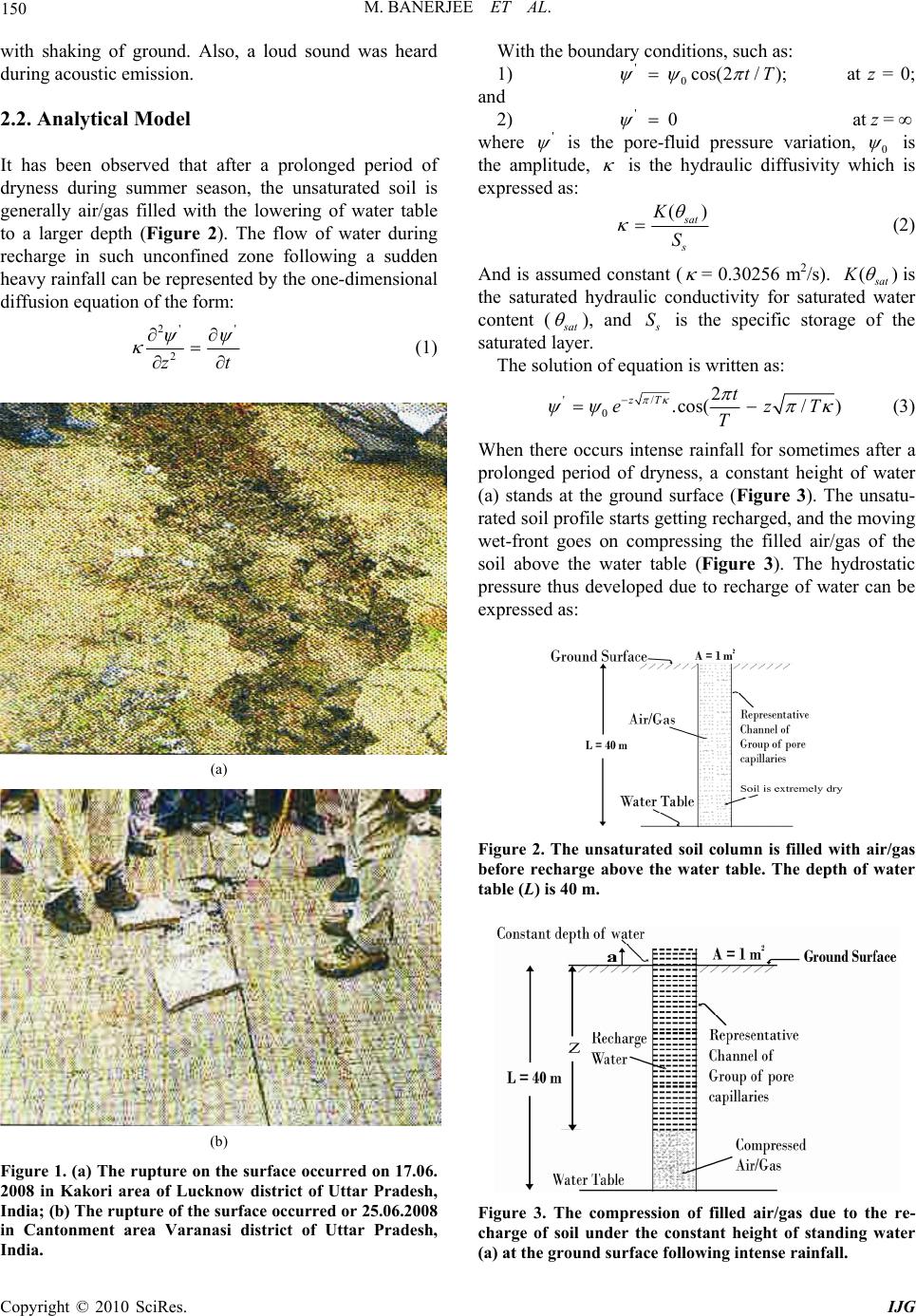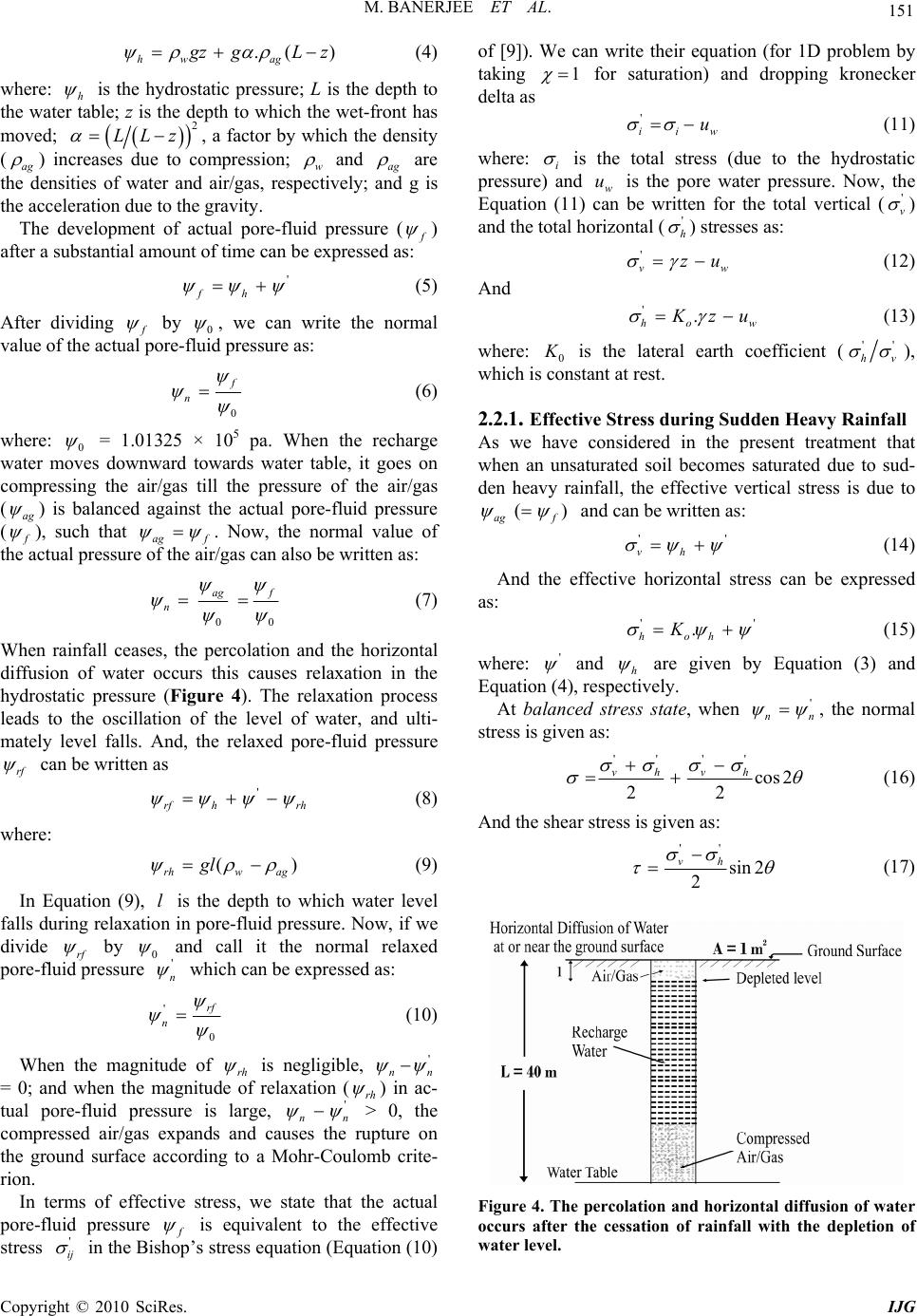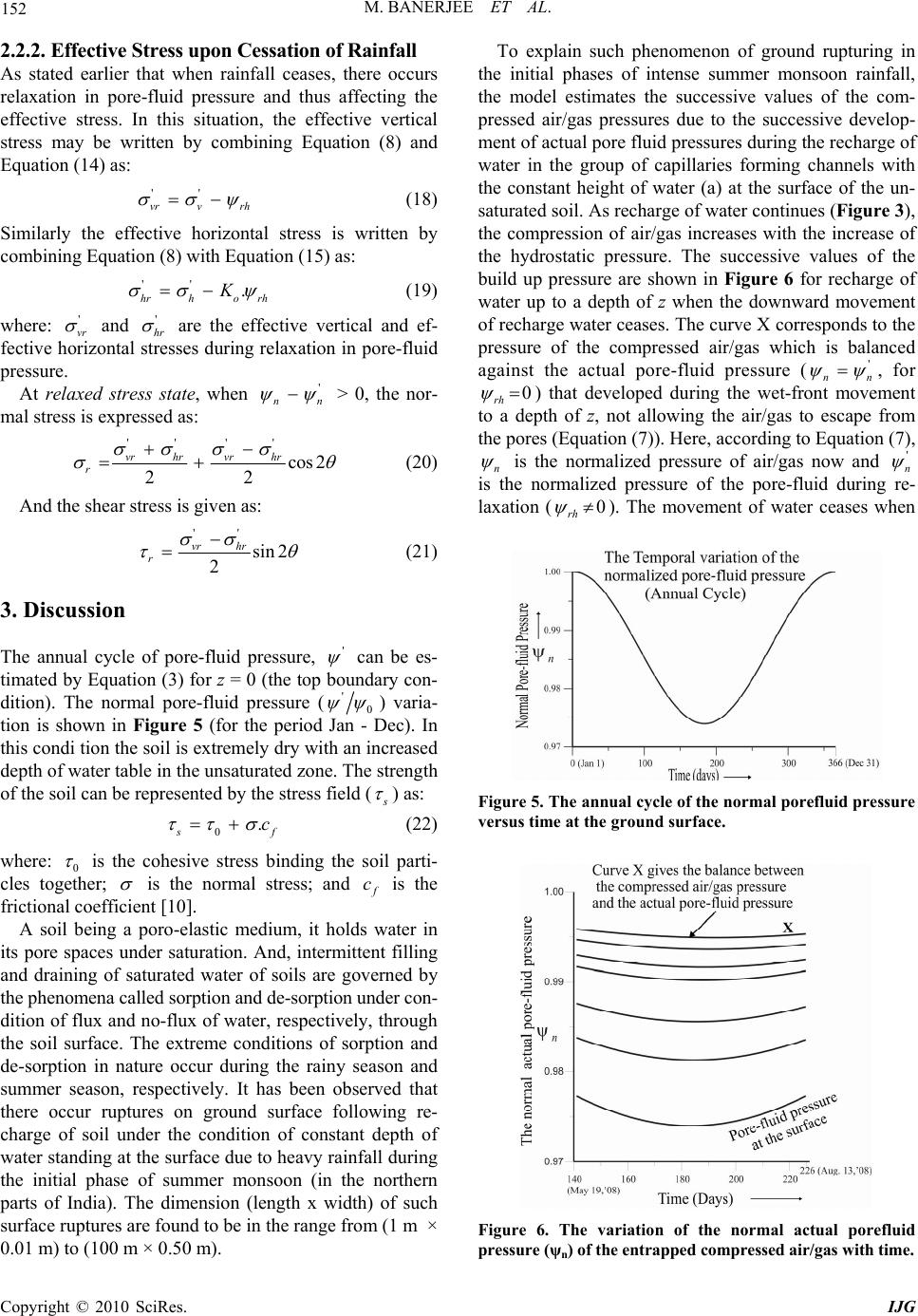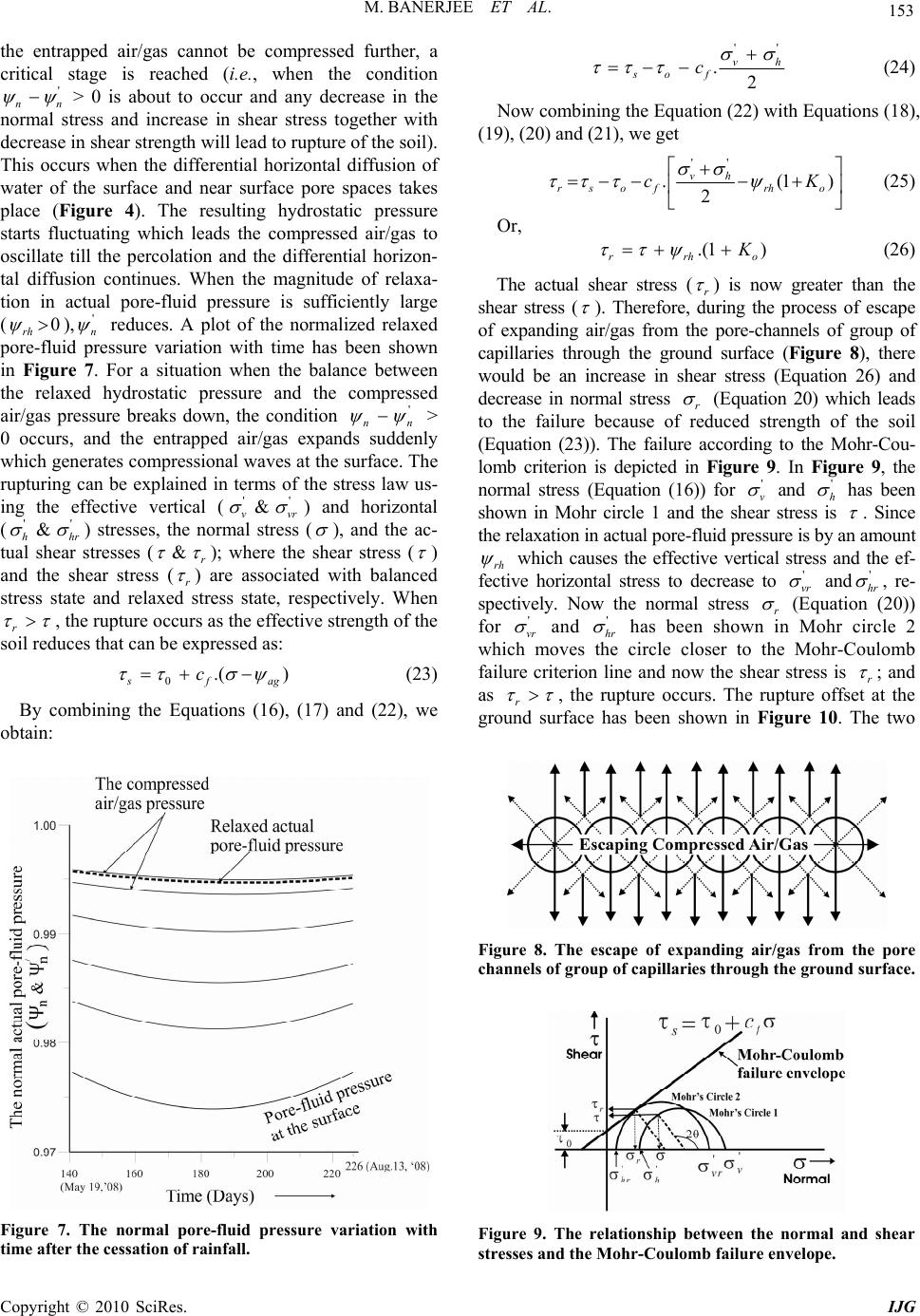Paper Menu >>
Journal Menu >>
 International Journal of Geosciences, 2010, 1, 149-154 doi:10.4236/ijg.2010.13019 Published Online November 2010 (http://www.SciRP.org/journal/ijg) Copyright © 2010 SciRes. IJG Ground Rupturing Due to Entrapped Air/Gas in the Unconfined Zone Manas Banerjee1*, Vimla Prasad Singh1, Hridaya Narain Singh1, Daya Shankar2, Sunjay1, Uma Shanker Singh1 1Department of Geophysics, Banaras Hindu University, Varanasi, India 2Department of Earthquake Engineering, University of Roorkee, Roorkee, India E-mail: manasgp@yahoo.co. in Received June 6, 2010; revised August 10, 2010; accepted August 30, 2010 Abstract The sudden and large oscillation of pressure of compressed air/gas entrapped in porous medium due to the changes in the actual pore-fluid pressure, during recharge of water following intense rainfall after a prolonged period of dryness such that the rainfall intensity exceeding infiltration capacity, leads to the generation of hydo-tremors. These hydro-tremors cause ground rupturing, subsidence, developments of cracks in the building, etc. A theoretical model has been presented to estimate the successive values of compressed air/gas pressures due to the successive development of actual pore-fluid pressures and effective stresses during recharge of water of the unconfined zone during the onset of the summer monsoon of 2008 in the northern parts of India. Keywords: Unconfined Zone, Compressed Air/Gas, Pore-Fluid Pressure, Hydro-Tremor, Ground Rupturing, Effective Stress 1. Introduction The phenomenon of hydro-seismicity is caused by the changes in pore-fluid pressure during subsurface re- charge of water following intense rainfall [1-6]. The re- charge of water to a depth 2-6 km initiates hydro- seis- micity caused by the hydrologic triggering of earthquake activity on critically stressed faults [3,7,8]; such tectonic earthquakes may be of magnitude Mw > 3. The tremors which has magnitude Mw < 3 and con- fined within the unsaturated zone is referred to here as hydro tremors. The hydro-tremors have been explained by a mechanism that takes into account the entrapped air/gas in pore spaces of soil above water table which gets compressed maximum due to the actual pore-fluid pressure following heavy rainfall, and upon relaxation of pore-fluid pressure (due to the horizontal diffusion of near surface water), the pressure of the compressed air/gas oscillates, and this causes hydro-tremors to gen- erate. The instant at which the air/gas expands suddenly due to the relaxation of compressive pore-fluid pressure, it develops effective stress [9] along the horizontal direc- tion during its escape from the capillary channels through the soil surface, which ruptures the ground surface. It has been observed that the increased difference of energy of the compressed air/gas inside the soil produces noisy sound energy during its escape. The associated hydro-tremor generates elastic waves which shakes the ground. These are the observed facts. The incidences of ground rupturing have been found in areas, experiencing depleted amount of rainfall over the years associated with mining of subsurface water, and have been reported from many parts of the northern states of India in the initial phases of heavy rainfall during the onset of 2008 summer monsoon. 2. Materials and Method 2.1. Observation The observed features of ground rupturing have been shown in Figures 1(a-b). Figures 1(a-b) show the rup- turing that occurred in the Kakori area of Lucknow dis- trict (on 17.06.2008) and in the Cantonment area of Va- ranasi district (on 25.06.2008) of Uttar Pradesh, India, respectively. The rupture dimensions were 0.1 to 0.5 m wide and 1 to 100 m long. During rupturing there was ejection of warm air/gas and water which was associated *Corresponding Author  150 M. BANERJEE ET AL. with shaking of ground. Also, a loud sound was heard during acoustic emission. 2.2. Analytical Model It has been observed that after a prolonged period of dryness during summer season, the unsaturated soil is generally air/gas filled with the lowering of water table to a larger depth (Figure 2). The flow of water during recharge in such unconfined zone following a sudden heavy rainfall can be represented by the one-dimensional diffusion equation of the form: 2' ' 2t z (1) (a) (b) Figure 1. (a) The rupture on the surface occurred on 17.06. 2008 in Kakori area of Lucknow district of Uttar Pradesh, India; (b) The rupture of the surface occurred or 25.06.2008 in Cantonment area Varanasi district of Uttar Pradesh, India. With the boundary conditions, such as: 1) at z = 0; ' 0cos(2/ );tT and 2 ) '0 at z = ∞ where ' is the pore-fluid pressure variation, 0 is the amplitude, is the hydraulic diffusivity which is expressed as: () s at s K S (2) And is assumed constant ( = 0.30256 m2/s). () s at K is the saturated hydraulic conductivity for saturated water content ( s at ), and s S is the specific storage of the saturated layer. The solution of equation is written as: '/ 0 2 .cos(/ ) zT t ez T T (3) When there occurs intense rainfall for sometimes after a prolonged period of dryness, a constant height of water (a) stands at the ground surface (Figure 3). The unsatu- rated soil profile starts getting recharged, and the moving wet-front goes on compressing the filled air/gas of the soil above the water table (Figure 3). The hydrostatic pressure thus developed due to recharge of water can be expressed as: Figure 2. The unsaturated soil column is filled with air/gas before recharge above the water table. The depth of water table (L) is 40 m. Figure 3. The compression of filled air/gas due to the re- charge of soil under the constant height of standing water (a) at the ground surface following intense rainfall. Copyright © 2010 SciRes. IJG  M. BANERJEE ET AL. 151 ).( hw ag g zg Lz (4) where: h is the hydrostatic pressure; L is the depth to the water table; z is the depth to which the wet-front has moved; 2 LLz , a factor by which the density (ag ) increases due to compression; w and ag are the densities of water and air/gas, respectively; and g is the acceleration due to the gravity. The development of actual pore-fluid pressure ( f ) after a substantial amount of time can be expressed as: ' fh (5) After dividing f by 0 , we can write the normal value of the actual pore-fluid pressure as: 0 f n (6) where: 0 = 1.01325 × 105 pa. When the recharge water moves downward towards water table, it goes on compressing the air/gas till the pressure of the air/gas (ag ) is balanced against the actual pore-fluid pressure ( f ), such that agf . Now, the normal value of the actual pressure of the air/gas can also be written as: 00 ag f n (7) When rainfall ceases, the percolation and the horizontal diffusion of water occurs this causes relaxation in the hydrostatic pressure (Figure 4). The relaxation process leads to the oscillation of the level of water, and ulti- mately level falls. And, the relaxed pore-fluid pressure rf can be written as ' rf hrh (8) where: ( rhw ag gl ) (9) In Equation (9), is the depth to which water level falls during relaxation in pore-fluid pressure. Now, if we divide rf l by 0 and call it the normal relaxed pore-fluid pressure ' n which can be expressed as: ' 0 rf n (10) When the magnitude of rh is negligible, ' nn = 0; and when the magnitude of relaxation (rh ) in ac- tual pore-fluid pressure is large, nn ' > 0, the compressed air/gas expands and causes the rupture on the ground surface according to a Mohr-Coulomb crite- rion. In terms of effective stress, we state that the actual pore-fluid pressure f is equivalent to the effective stress ' ij in the Bishop’s stress equation (Equation (10) of [9]). We can write their equation (for 1D problem by taking 1 for saturation) and dropping kronecker delta as ' ii u w (11) where: i is the total stress (due to the hydrostatic pressure) and w is the pore water pressure. Now, the Equation (11) can be written for the total vertical ( u ' v ) and the total horizontal (' h ) stresses as: ' v zu w (12) And '. ho w K zu (13) where: 0 K is the lateral earth coefficient (' hv ' ), which is constant at rest. 2.2.1. Effective Stress during Sudden Heavy Rainfall As we have considered in the present treatment that when an unsaturated soil becomes saturated due to sud- den heavy rainfall, the effective vertical stress is due to () fag and can be written as: ' vh' (14) And the effective horizontal stress can be expressed as: ' . hoh K' (15) where: ' and h are given by Equation (3) and Equation (4), respectively. At balanced stress state, when ' nn , the normal stress is given as: '' '' cos 2 22 vh vh (16) And the shear stress is given as: '' sin 2 2 vh (17) Figure 4. The percolation and horizontal diffusion of water occurs after the cessation of rainfall with the depletion of water level. Copyright © 2010 SciRes. IJG  152 M. BANERJEE ET AL. 2.2.2. Effective Stress upon Cessation of Rainfall As stated earlier that when rainfall ceases, there occurs relaxation in pore-fluid pressure and thus affecting the effective stress. In this situation, the effective vertical stress may be written by combining Equation (8) and Equation (14) as: '' vr v rh (18) Similarly the effective horizontal stress is written by combining Equation (8) with Equation (15) as: '' . hrhorh K (19) where: ' vr and ' hr are the effective vertical and ef- fective horizontal stresses during relaxation in pore-fluid pressure. At relaxed stress state, when ' nn > 0, the nor- mal stress is expressed as: '' '' cos 2 22 vr hrvr hr r (20) And the shear stress is given as: '' sin 2 2 vr hr r (21) 3. Discussion The annual cycle of pore-fluid pressure, ' can be es- timated by Equation (3) for z = 0 (the top boundary con- dition). The normal pore-fluid pressure (' 0 ) varia- tion is shown in Figure 5 (for the period Jan - Dec). In this condi tion the soil is extremely dry with an increased depth of water table in the unsaturated zone. The strength of the soil can be represented by the stress field ( s ) as: 0. s f c (22) where: 0 is the cohesive stress binding the soil parti- cles together; is the normal stress; and f c is the frictional coefficient [10]. A soil being a poro-elastic medium, it holds water in its pore spaces under saturation. And, intermittent filling and draining of saturated water of soils are governed by the phenomena called sorption and de-sorption under con- dition of flux and no-flux of water, respectively, through the soil surface. The extreme conditions of sorption and de-sorption in nature occur during the rainy season and summer season, respectively. It has been observed that there occur ruptures on ground surface following re- charge of soil under the condition of constant depth of water standing at the surface due to heavy rainfall during the initial phase of summer monsoon (in the northern parts of India). The dimension (length x width) of such surface ruptures are found to be in the range from (1 m × 0.01 m) to (100 m × 0.50 m). To explain such phenomenon of ground rupturing in the initial phases of intense summer monsoon rainfall, the model estimates the successive values of the com- pressed air/gas pressures due to the successive develop- ment of actual pore fluid pressures during the recharge of water in the group of capillaries forming channels with the constant height of water (a) at the surface of the un- saturated soil. As recharge of water continues (Figure 3), the compression of air/gas increases with the increase of the hydrostatic pressure. The successive values of the build up pressure are shown in Figure 6 for recharge of water up to a depth of z when the downward movement of recharge water ceases. The curve X corresponds to the pressure of the compressed air/gas which is balanced against the actual pore-fluid pressure (n ' n , for 0 rh ) that developed during the wet-front movement to a depth of z, not allowing the air/gas to escape from the pores (Equation (7)). Here, according to Equation (7), n is the normalized pressure of air/gas now and ' n is the normalized pressure of the pore-fluid during re- laxation (0 rh ). The movement of water ceases when Figure 5. The annual cycle of the normal porefluid pressure versus time at the ground surface. Figure 6. The variation of the normal actual porefluid pressure (ψn) of the entrapped compressed air/gas with time. Copyright © 2010 SciRes. IJG  M. BANERJEE ET AL. 153 the entrapped air/gas cannot be compressed further, a critical stage is reached (i.e., when the condition n ' n 0 rh > 0 is about to occur and any decrease in the normal stress and increase in shear stress together with decrease in shear strength will lead to rupture of the soil). This occurs when the differential horizontal diffusion of water of the surface and near surface pore spaces takes place (Figure 4). The resulting hydrostatic pressure starts fluctuating which leads the compressed air/gas to oscillate till the percolation and the differential horizon- tal diffusion continues. When the magnitude of relaxa- tion in actual pore-fluid pressure is sufficiently large ( ), ' n reduces. A plot of the normalized relaxed pore-fluid pressure variation with time has been shown in Figure 7. For a situation when the balance between the relaxed hydrostatic pressure and the compressed air/gas pressure breaks down, the condition n ' n > 0 occurs, and the entrapped air/gas expands suddenly which generates compressional waves at the surface. The rupturing can be explained in terms of the stress law us- ing the effective vertical (vr ' & v' ) and horizontal (hr ' & h' ) stresses, the normal stress ( ), and the ac- tual shear stresses (&r ); where the shear stress ( ) and the shear stress (r ) are associated with balanced stress state and relaxed stress state, respectively. When r , the rupture occurs as the effective strength of the soil reduces that can be expressed as: 0.( ) s f cag (23) By combining the Equations (16), (17) and (22), we obtain: Figure 7. The normal pore-fluid pressure variation with time after the cessation of rainfall. '' .2 v so f ch (24) Now combining the Equation (22) with Equations (18), (19), (20) and (21), we get '' .(1 2 vh rsofrh o cK ) (25) Or, .(1 ) rrho K (26) The actual shear stress (r ) is now greater than the shear stress ( ). Therefore, during the process of escape of expanding air/gas from the pore-channels of group of capillaries through the ground surface (Figure 8), there would be an increase in shear stress (Equation 26) and decrease in normal stress r (Equation 20) which leads to the failure because of reduced strength of the soil (Equation (23)). The failure according to the Mohr-Cou- lomb criterion is depicted in Figure 9. In Figure 9, the normal stress (Equation (16)) for ' v and ' h has been shown in Mohr circle 1 and the shear stress is . Since the relaxation in actual pore-fluid pressure is by an amount rh which causes the effective vertical stress and the ef- fective horizontal stress to decrease to ' vr and' hr , re- spectively. Now the normal stress r (Equation (20)) for ' vr and ' hr has been shown in Mohr circle 2 which moves the circle closer to the Mohr-Coulomb failure criterion line and now the shear stress is r ; and as r , the rupture occurs. The rupture offset at the ground surface has been shown in Figure 10. The two Figure 8. The escape of expanding air/gas from the pore channels of group of capillaries through the ground surface. Figure 9. The relationship between the normal and shear stresses and the Mohr-Coulomb failure envelope. Copyright © 2010 SciRes. IJG  M. BANERJEE ET AL. Copyright © 2010 SciRes. IJG 154 Figure 10. The rupture offset due to the ruptu gures (Figure 8 and Figure 10) also depict the resu ring of ground surface. fi ltant force vectors due to the escaping compressed air/gas which are perpendicular to the rupture offset boundaries. The rupture offset is proportional to the magnitude of the energy (E) released which is generally of the order of 107 J to 107.2 J. (The energy is calculated using the formula: 2. w EghA ; where w = 1000 kg/m3, g = 9.8 m/s2, h = 100 . This is equivalent of energy magnitude (Mw = 1.2 to 1.3). The energy magnitude is calculated as(log5.24) /1.44 w ME . It has been observed that ith ejection of warm air/gas and water, and sometimes, with subsidence at places. And, during rupturing there generates the hy- dro-tremors. = 40 m and A t m2) cehis pross is associated w 4. Conclusion The mechanism of the proposed model could explai he authors are thankful to the Computer Centre, B n the [8] L . W. Wolf, C. A. Rowe and R. B. Horner, “Periodic Seismicity near Mt. Ogden on the Alska-British Colum- bia Border: A Case for Hydrologically Triggered Earth- quakes,” Bulletin of Seismological Society of America, Vol. 87, 1997, pp. 1473-1483. incidence of ground rupturing in the areas experiencing depleted amount of rainfall over the years associated with mining of subsurface water, and have been reported from many parts of the northern states of India in the initial phases of heavy rainfall during the onset of 2008 summer monsoon. 5. Acknowledgements T ana- ras Hindu University for providing needful facilities for computational works. 6. References [1] J. K. Costain, G. A. Bollinger and J. A. Speer, “Hy- dro-Seismicity: A Hypothesis for the Role of Water in the Generation of Intraplate Seismicity,” Seismological Re- search Letter, Vol. 58, 1987, pp. 41-64. [2] P. Roth, N. Pavoni and N. Deichmann, “Seismotectonics of the Eastern Swiss Alps and Evidence for Precipita- tion-Induced Variations of Seismic Activity,” Tectono- physics, Vol. 207, 1992, pp. 183-197. [3] H. K. Gupta, “Reservoir-Induced Earthquakes,” Elsevier, New York, 1992. [4] M. Manga, “A Model for Discharge in Spring-Dominated Streams and Implications for the Transmissivity and Re- charge of Quaternary Volcanics in the Oregon Cascades,” Water Resources Research, Vol. 33, 1997, pp. 1813- 1822. [5] M.-J. Jimenez and M. Garcia-Fernandez, “Occurrence of Shallow Earthquakes Following Periods of Intense Rain- fall in Tenerife, Canary Islands,” Journal of Volcanology and Geothermic Research, Vol. 103, 2000, pp. 463-468. [6] H. Ogasawara, K. Fujimori, N. Koizumi, N. Hirano, S. Fujiwara, S. Otsuka, S. Nakao, K. T. Nishigami, Y. Iio, R. Nishida, K. Oike and Y. Tanaka, “Micro-Seismicity In- duced by Heavy Rainfall around Flooded Vertical Ore Veins,” Pure and Applied Geophysics, Vol. 159, 2002, pp. 91-109. [7] M. D. Zoback and J. H. Healy, “Friction, Faulting and In-Situ Stress,” Annals of Geophysics, Vol. 2, 1984, pp. 689-698. [9] Nuth, Mathieu, Laloui and Lyesse, “Effective Stress Con- cept in Unsaturated Soils: Clarification and Validation of a Unified Framework,” International Journal of Numeri- cal and Analytical Methods in Geomechanics, Vol. 32, 2008, pp. 771-801. [10] K. Kasahara, “Earthquake Mechanics,” Cambridge Uni- versity Press, Cambridge, 1981. |

